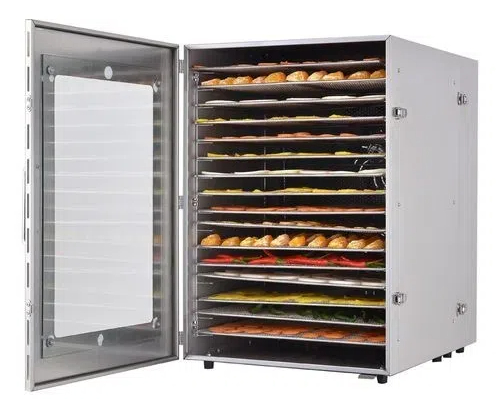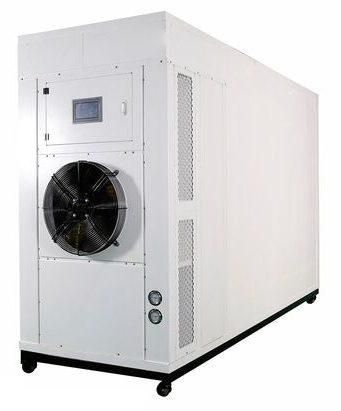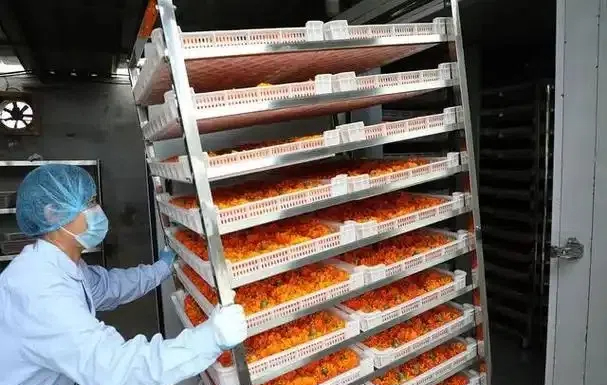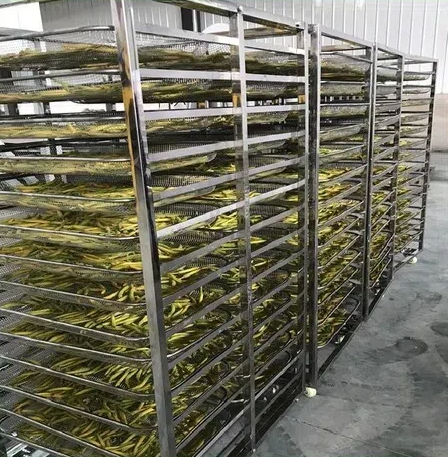
Content Menu
● Understanding Food Drying
● What is a Heat Pump Dryer?
>> Advantages of Heat Pump Dryers
● What is a Ventilation Dryer?
>> Advantages of Ventilation Dryers
● Key Differences Between Heat Pump Dryers and Ventilation Dryers
● Choosing the Right Dryer for Your Needs
● The Role of Technology in Food Drying
● Environmental Considerations
● Conclusion
● Frequently Asked Questions
>> 1. What is the main advantage of using a heat pump dryer?
>> 2. Can I use a ventilation dryer for all types of food?
>> 3. How do I maintain my food drying machine?
>> 4. What is the typical drying time for food in these machines?
>> 5. Are heat pump dryers more expensive than ventilation dryers?
In the world of food processing, drying is a crucial step that helps preserve food, enhance flavors, and extend shelf life. As a leading manufacturer of food drying machines in China, we provide OEM services to international brands, wholesalers, and producers. This article will explore the differences between heat pump dryers and ventilation dryers, focusing on their applications in food drying, efficiency, and overall performance.

Understanding Food Drying
Food drying is a method of food preservation that removes moisture from food products, inhibiting the growth of bacteria, yeasts, and molds. This process can be achieved through various methods, including sun drying, air drying, and using specialized drying machines. Among these, heat pump dryers and ventilation dryers are two popular options in the industry.
What is a Heat Pump Dryer?
A heat pump dryer is a type of drying machine that uses a refrigeration cycle to remove moisture from food products. It operates by extracting heat from the air and transferring it to the drying chamber, where it evaporates moisture from the food. The moisture-laden air is then condensed and removed, allowing for efficient drying.
Advantages of Heat Pump Dryers
1. Energy Efficiency: Heat pump dryers are known for their low energy consumption. They can operate at lower temperatures, which is particularly beneficial for drying sensitive food products without compromising quality.
2. Consistent Drying: These dryers provide uniform heat distribution, ensuring that all food items are dried evenly. This consistency is crucial for maintaining the quality and flavor of the food.
3. Environmental Impact: Heat pump dryers have a lower carbon footprint compared to traditional drying methods, making them a more sustainable choice for food processing.
4. Versatility: They can be used for a wide range of food products, including fruits, vegetables, herbs, and meats.
5. Reduced Risk of Over-Drying: The controlled environment of heat pump dryers minimizes the risk of over-drying, which can lead to loss of nutrients and flavor.
What is a Ventilation Dryer?
A ventilation dryer, also known as a vented dryer, uses hot air to remove moisture from food products. It works by blowing hot air into the drying chamber, where it circulates around the food items. The moisture is then expelled through a vent, allowing for continuous airflow.

Advantages of Ventilation Dryers
1. Faster Drying Times: Ventilation dryers typically have shorter drying times compared to heat pump dryers, making them suitable for large-scale operations where speed is essential.
2. Simplicity of Design: These dryers have a straightforward design, which can make them easier to maintain and operate.
3. Lower Initial Cost: Ventilation dryers are often less expensive to purchase than heat pump dryers, making them an attractive option for smaller businesses or startups.
4. High Airflow Capacity: The design of ventilation dryers allows for high airflow, which can be beneficial for drying larger batches of food quickly.
5. Less Sensitivity to Ambient Conditions: Ventilation dryers can operate effectively in various environmental conditions, making them versatile for different settings.
Key Differences Between Heat Pump Dryers and Ventilation Dryers
1. Energy Consumption:
Heat pump dryers are more energy-efficient, using less electricity to achieve the same drying results.
Ventilation dryers consume more energy due to the need for constant heating and ventilation.
2. Drying Temperature:
Heat pump dryers operate at lower temperatures, which is ideal for delicate food items.
Ventilation dryers use higher temperatures, which can be suitable for robust products but may risk damaging sensitive foods.
3. Moisture Removal:
Heat pump dryers recycle moisture, condensing it back into water, which can be beneficial for maintaining humidity levels in the drying chamber.
Ventilation dryers expel moisture directly, which can lead to a drier environment but may require more energy to maintain temperature.
4. Cost and Maintenance:
Heat pump dryers generally have a higher initial cost but lower operating costs over time due to their energy efficiency.
Ventilation dryers are cheaper to buy but may incur higher energy bills and require more frequent maintenance.
5. Application Suitability:
Heat pump dryers are versatile and suitable for a wide range of food products, especially those sensitive to heat.
Ventilation dryers are better suited for products that can withstand higher temperatures and require quick drying.
Choosing the Right Dryer for Your Needs
When selecting a drying machine for food processing, it is essential to consider the specific needs of your operation. Factors such as the type of food being dried, production volume, and energy costs should all play a role in your decision.
1. For Delicate Foods: If you are processing fruits, herbs, or other sensitive items, a heat pump dryer may be the best choice due to its gentle drying process and energy efficiency.
2. For Large-Scale Operations: If speed and volume are your primary concerns, a ventilation dryer may be more suitable, especially if you are drying robust products like vegetables or meats.
The Role of Technology in Food Drying
Advancements in technology have significantly improved the efficiency and effectiveness of food drying machines. Modern heat pump dryers are equipped with smart controls that allow operators to monitor and adjust drying parameters in real-time. This capability ensures optimal drying conditions and can lead to better product quality.
Similarly, ventilation dryers have also benefited from technological improvements. Enhanced airflow systems and temperature controls help maintain consistent drying conditions, reducing the risk of uneven drying and product spoilage.
Environmental Considerations
As the food industry becomes increasingly aware of its environmental impact, the choice of drying technology plays a crucial role. Heat pump dryers, with their lower energy consumption and reduced carbon footprint, align well with sustainable practices. They are particularly appealing to businesses looking to enhance their green credentials.
On the other hand, while ventilation dryers may have a higher energy consumption, their ability to operate effectively in various conditions can make them a practical choice for certain applications. Businesses must weigh the environmental impact against operational needs when selecting a drying solution.
Conclusion
In conclusion, both heat pump dryers and ventilation dryers have their unique advantages and applications in the food drying industry. Understanding the differences between these two types of dryers can help you make an informed decision that aligns with your business needs. As a manufacturer of food drying machines, we are committed to providing high-quality, efficient solutions tailored to your requirements.

Frequently Asked Questions
1. What is the main advantage of using a heat pump dryer?
The main advantage is its energy efficiency, allowing for lower operating costs and gentle drying of sensitive foods.
2. Can I use a ventilation dryer for all types of food?
While ventilation dryers are versatile, they are best suited for robust foods that can withstand higher temperatures.
3. How do I maintain my food drying machine?
Regular cleaning, checking for blockages, and ensuring proper airflow are essential for maintaining both heat pump and ventilation dryers.
4. What is the typical drying time for food in these machines?
Drying times vary based on the type of food and the machine used, but heat pump dryers generally take longer due to their lower temperatures.
5. Are heat pump dryers more expensive than ventilation dryers?
Yes, heat pump dryers typically have a higher initial cost but offer lower energy bills over time.












